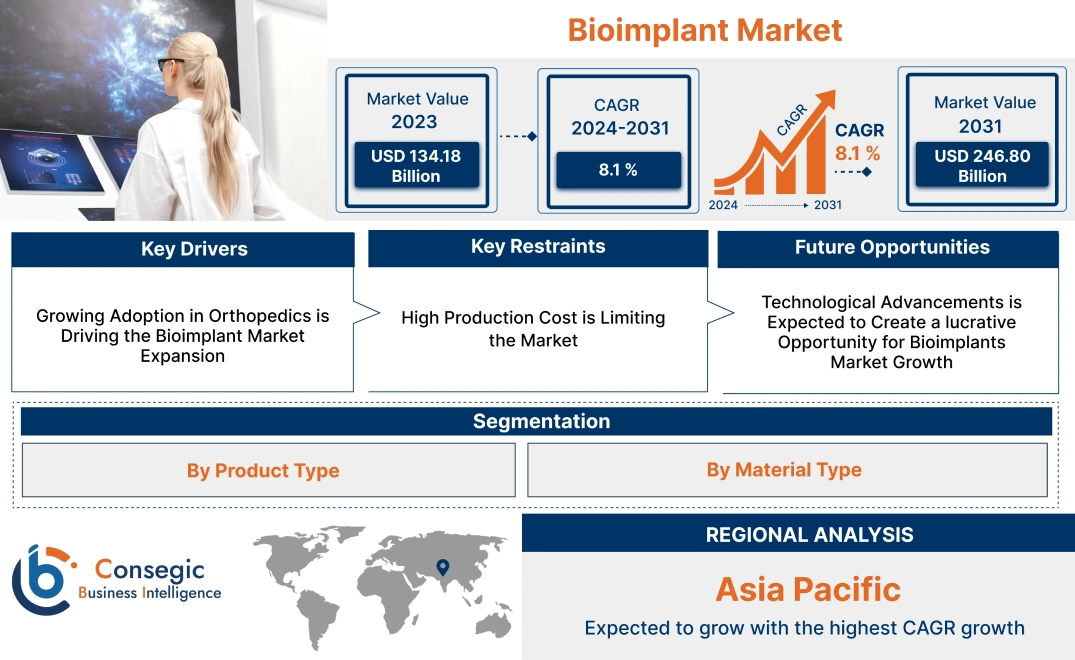- Summary
- Table Of Content
- Methodology
Bioimplant Market Size:
Bioimplant Market size is growing with a CAGR of 8.1% during the forecast period (2024-2031), and the market is projected to be valued at USD 246.80 Billion in 2031 from USD 134.18 Billion in 2023.
Bioimplant Market Scope & Overview:
Bioimplants are products that are composed of biosynthetic materials that replace non-functional or broken biological structural parts of the body. These are classified into various types based on the material such as ceramic, polymers, and metallic.
Ceramics type is noted for their great biocompatibility, which makes them an ideal product for biomedical implant applications such as orthopedics, and dentistry amongst others. Polymer type are sub categorized into biodegradable polymers and non-biodegradable polymers. Biodegradable polymer type which includes polyacetal, chitosan (CS), alginate, polylactide, polycaprolactone, and others. Non-biodegradable polymers type include polypropylene, polytetrafluoroethylene, polyethylene terephthalate, polymethylmethacrylate, and more. Polymer types are mostly used in replacing heart valves, kidneys, bone, skin, contact lenses, artificial blood vessels, and others.
Metals and alloy types are generally used as bioimplants due to their high strength and load-bearing capacity. They are used in load-bearing applications such as hip, plates, pins, dental materials, screws, and more. They improve an individual's quality of life, by restoring the function of the damaged body part. Additionally, it demonstrates reduced probability of infection, reduced chances of rejection, and others. Globally, they are majorly used in medical applications to fix fractures, replace a bone, or support the healing process of a damaged bone. They are extensively used in dental care, orthopedics, cardiology, and others.
Bioimplant Market Dynamics - (DRO) :
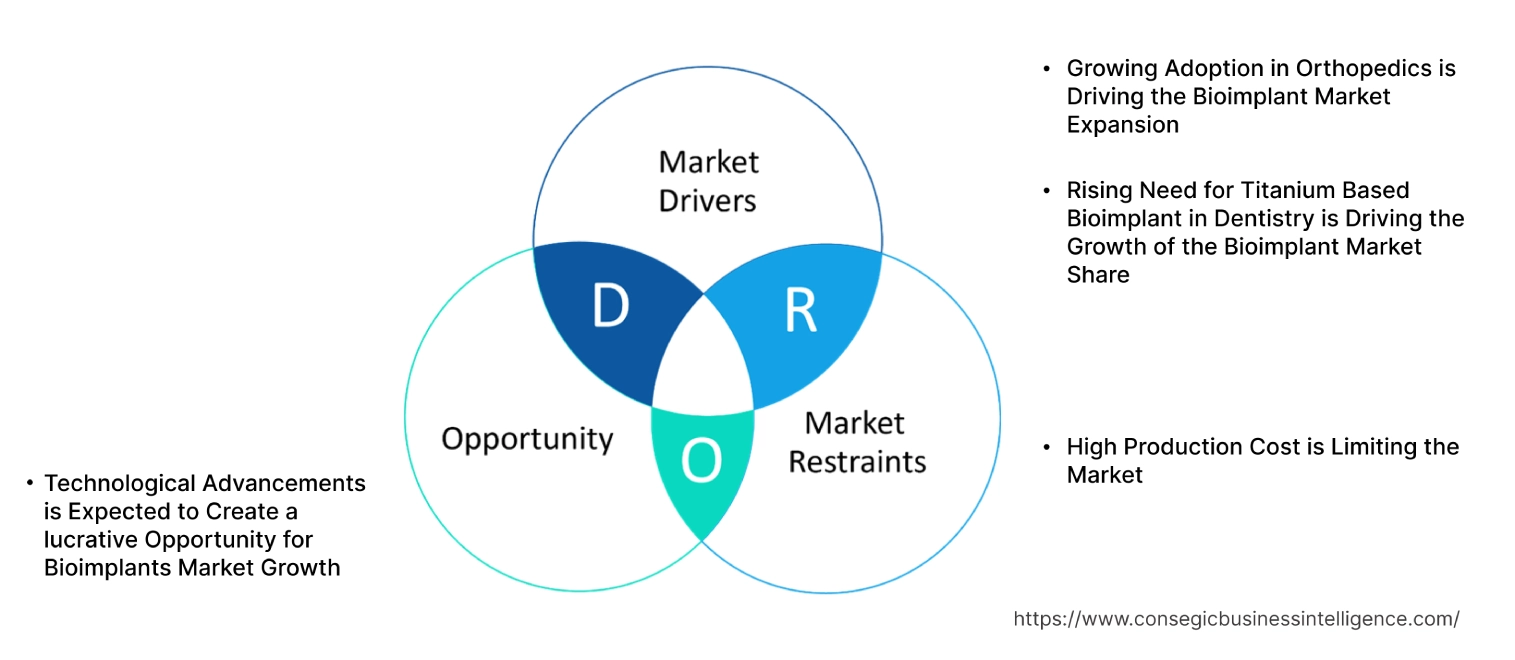
Key Drivers:
Growing Adoption in Orthopedics is Driving the Bioimplant Market Expansion
Globally, accident victims with broken bones require bioimplants that replace the damaged bone or support bone healing. Orthopedic surgeons have been using metallic bioimplants for the fixation of bone fractures. They provide a similar function to that of the natural bone in patients suffering bone fractures and improve their quality of life. Additionally, temporary fracture-fixing tools and parts such as plates, screws, pins, and others are increasingly used as orthopedic implants.
Moreover, globally, hip and knee replacements are common elective orthopedic surgical procedures that are increasingly performed for the treatment of hip and knee pain in the end stage of osteoarthritis.
- In 2023 according to a National Center of Biotechnology Information, over 200,000 hip and knee replacements are performed each year in the United Kingdom. Bioimplants in these bone replacements play a vital role in restoring mobility and pain reduction in patients.
Thus, as per the analysis of the market trend, due to the global increase in the adoption rate in orthopedics, the market is expanding.
Rising Need for Titanium Based Bioimplant in Dentistry is Driving the Growth of the Bioimplant Market Share
Globally, pure titanium and titanium alloys are widely used materials in preparing bioimplants. Titanium based bioimplants are increasingly opted in dentistry due to their long fatigue life, corrosion resistance, and high biocompatibility compared to other implants. Furthermore, the properties of titanium make it an ideal material for dental bioimplants, as it integrates well with bone tissue, providing a durable and stable foundation for artificial teeth.
- In 2021 according to The National Center of Biotechnology Information, globally, pure titanium and titanium alloys based bioimplants are the most widely preferred metallic type bioimplant in dentistry.
Thus, as per the analysis of the market trend, due to the increased use of titanium-based bioimplants in dentistry, the market is expanding.
Key Restraints :
High Production Cost is Limiting the Market
High cost in manufacturing are restricting the bioimplant market growth. Due to the rising cost of raw materials, manufacturers are facing difficulty in balancing the price. Furthermore, titanium and zirconia, both of which have seen significant price increases due to supply chain disruptions and rising global demand.
Additionally, the energy required for machining and treating materials used for preparing bioimplants, along with the costs of skilled labour, has increased, adding pressure at every step of production. As a result, they are already being considered a premium product, and are becoming even more expensive.
- In 2024, according to Smile Delhi – The Dental Clinic, in United States the cost of a single dental bioimplant ranges from $3,000 to $5,000. In the UK, it ranges from $2,575 to $3,218 and the National Health Service (NHS) does not provide insurance cover for dental bioimplants.
Therefore, due to increased prices, the bioimplant market expansion is limited.
Future Opportunities :
Technological Advancements is Expected to Create a lucrative Opportunity for Bioimplants Market Growth.
Technological Advancements is Expected to Create a lucrative Opportunity for Bioimplants Market Growth
The technological advancement of Artificial Intelligence (AI) and Machine learning (ML) driven bioimplant manufacturing in turn expected to shape the healthcare landscape and reduce revision surgeries. AI and ML algorithms, such as neural networks, support vector machines, and random forests, illustrate their applications through case studies that address enhanced quality control, optimize designs, and provide personalized bioimplants. Hence AI and ML-driven manufacturing will help manufacturers produce bioimplants with precision and increased efficiency. It also helps develop more patient specific solutions.
- In 2024 according to the National Center of Biotechnology Information, merging ML with intricate analytical methodologies offers significant insights, refining designs for hip bioimplants amongst others to amplify patient comfort and efficacy.
Thus, the technological advancement in manufacturing, due to its increased efficacy and efficiency is expected to drive the bioimplant market opportunity in upcoming years.
Bioimplant Market Segmental Analysis :
By Product Type:
Based product types the segment is categorized into orthopedic bioimplants, dental bioimplants, cardiovascular bioimplants, and others.
Trends in the Product Type:
- Growing need of orthopedic bioimplants, as it enhances bone healing and tissue regeneration.
- Cardiac bioimplants improve the survival rate of patients with cardiological disorder.
The orthopedic bioimplants account for the largest revenue of the total market share of 43.75% in the year 2023.
- Globally, the use of orthopedic bioimplants has increase in treatment of patients with debilitating diseases like osteoarthritis and bone fractures among others.
- In order to repair or replace bones and joints that are damaged or deformed, they are being increasingly adopted in orthopedic procedures.
- In 2023, according to National Center of Biotechnology Information and American Association of Hip and Knee Surgeons, the number of hip and knee implant procedures including traditional bioimplants are performed in the United States is been observed to have increased between 2021 and 2022.
- Thus, as per the analysis of segmental trend, globally orthopedic bioimplant is dominating the bioimplants market trend.
Dental bioimplants segment is anticipated to register the fastest CAGR during the forecast period.
- Globally there is a rising need for dental bioimplants, as they offer permanent solutions to tooth loss. These have an extended life span and improve appearance and function, hence increasingly preferred by individuals suffering from tooth loss.
- They are made from strong materials and provide a sturdy implant foundation for artificial teeth, further reducing the risk of oral health problems such as tooth decay, gum disease, and more.
- In 2022 according to the National Center of Biotechnology Information, among the different materials available, titanium dental bioimplants are increasingly preferred due to their biocompatibility and low cost.
- Thus, as per the analysis of segmental trends, the market is expected to rise, due to its rising demand.
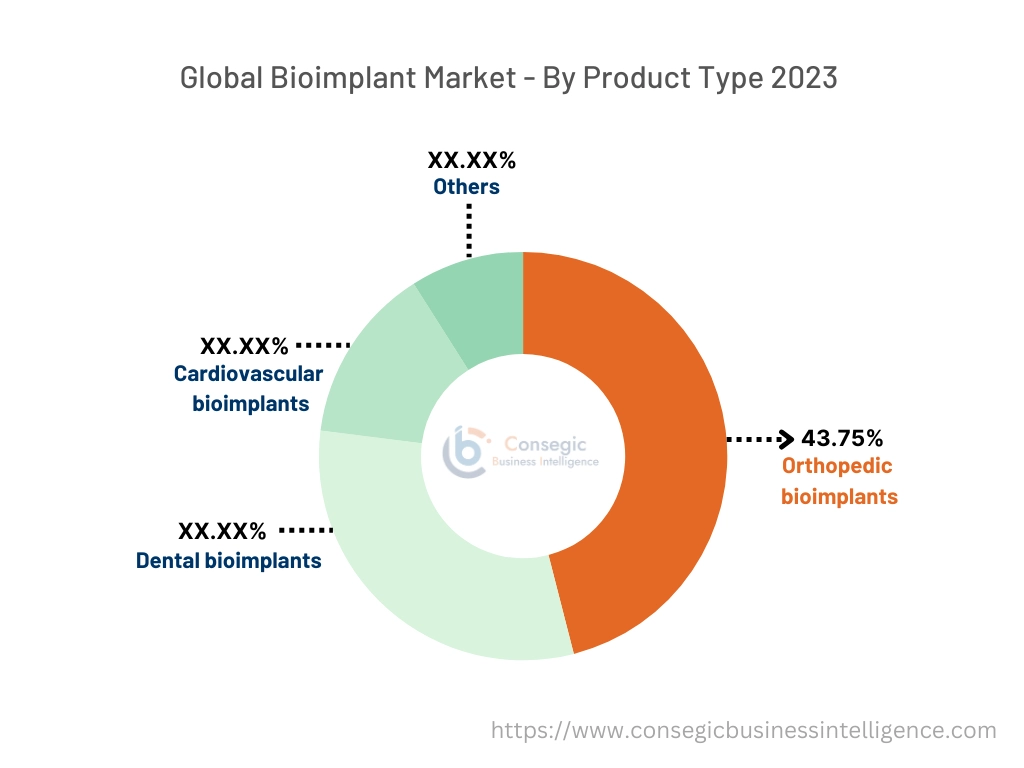
By Material Type:
Based on material type the market is segmented into metallic, ceramic, polymer, and others.
Trends in the Material Type:
- Titanium among the metallic bioimplant are extensively preferred due to its high strength low weight and excellent biocompatibility.
- Increased use of biodegradable polymeric temporary bioimplant as they eliminated the need for surgical removal after the healing process is completed.
The metallic bioimplant accounted for the largest revenue share in the year 2023.
- Globally, metallic bioimplants are increasingly used due to their high strength, high fracture toughness, corrosion resistance and biocompatibility.
- Due to their exceptional characteristics, they are increasingly used in joint replacement, tooth replacement, amongst others.
- Most of the total hip femoral stem and total shoulder arthroplasty stems components are made of a titanium alloy which is a type of metallic bioimplant.
- In 2023, according to the National Center of Biotechnology Information, globally, titanium based metallic bioimplants is widely used for implantation in orthopedic surgery due to their excellent biocompatibility.
- Thus, the bioimplant market analysis concludes that metallic type bioimplant is dominating globally.
The polymer segment is anticipated to register the fastest CAGR during the forecast period.
- Globally, in dentistry, polymer-based bioimplants are increasingly used due to its low elastic feature.
- Their manufacturing is cost effective and they have the ability to be molded in different shapes, leading to increasing usage as orthopedic implants and cardiovascular implants.
- In 2023 according to the National Center of Biotechnology Information, the use of polymeric biomaterials in prosthodontics and dental implantology is rising due to its increased durability, increased strength, and light weightedness.
- Thus, as per the segmental trend of market analysis, polymer type of bioimplants is expected to demonstrate a substantial rise in upcoming years due to its increasing adoption in dentistry, orthopedics, and cardiovascular among others.
Regional Analysis:
The regional segment includes North America, Europe, Asia Pacific, the Middle East and Africa, and Latin America.
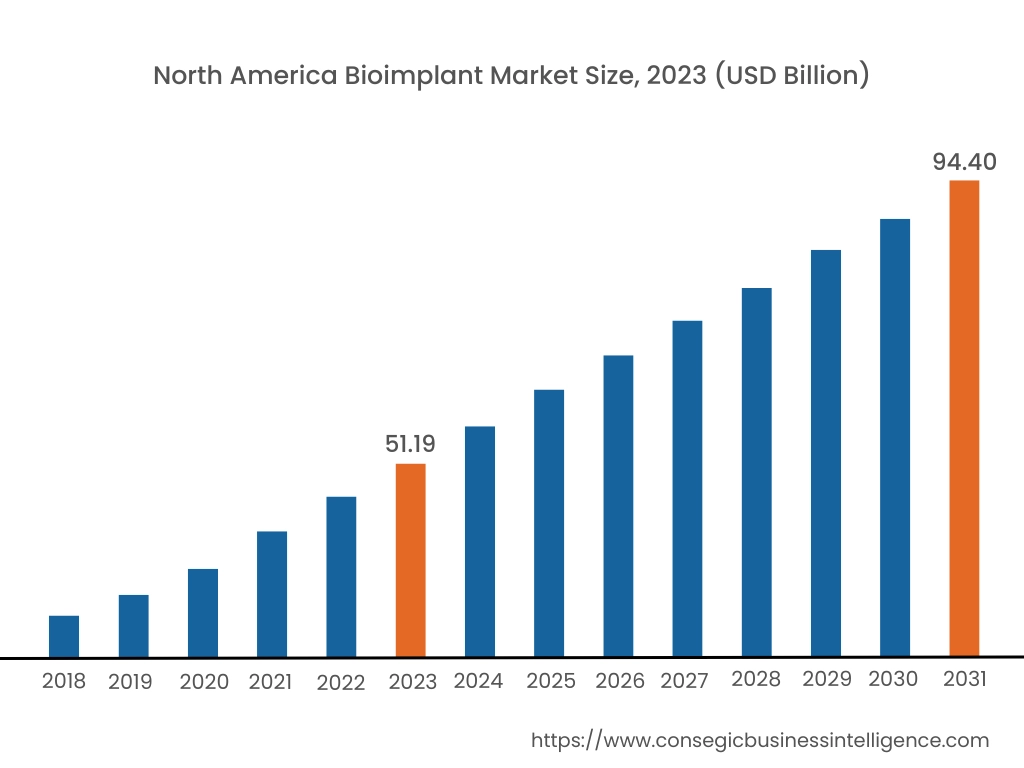
In 2023, North America accounted for the highest market share at 38.15% and was valued at USD 51.19 Billion, and is expected to reach USD 94.40 Billion in 2031. In North America, United States accounted for the highest market share of 71.71% during the base year of 2023. In North America there is the increase in use of bioimplants in orthopedics as they promote better integration with bone tissue and has lower risk of rejection. Knee injuries is one of the main things that is driving the growth of the bioimplants market in United States. Products such as plate, screws, amongst others are increasingly used to treat bone related problems in patients with orthopedic diseases.
- In 2024, according to uteshiyamedicare, one of the leading manufacturing industry and supplier of orthopedic bioimplants, every year about 150,000 anterior cruciate ligament tears occurs in the United States. As bioimplant acts as a bridge to help the torn ends. Its use for treating anterior cruciate ligament tears is rising in orthopedics, thereby increasing the recovery rate of knee injury among orthopedics patients in United States.
Thus, due to its increased use in orthopedics, the bioimplant market trend is rising in North America.
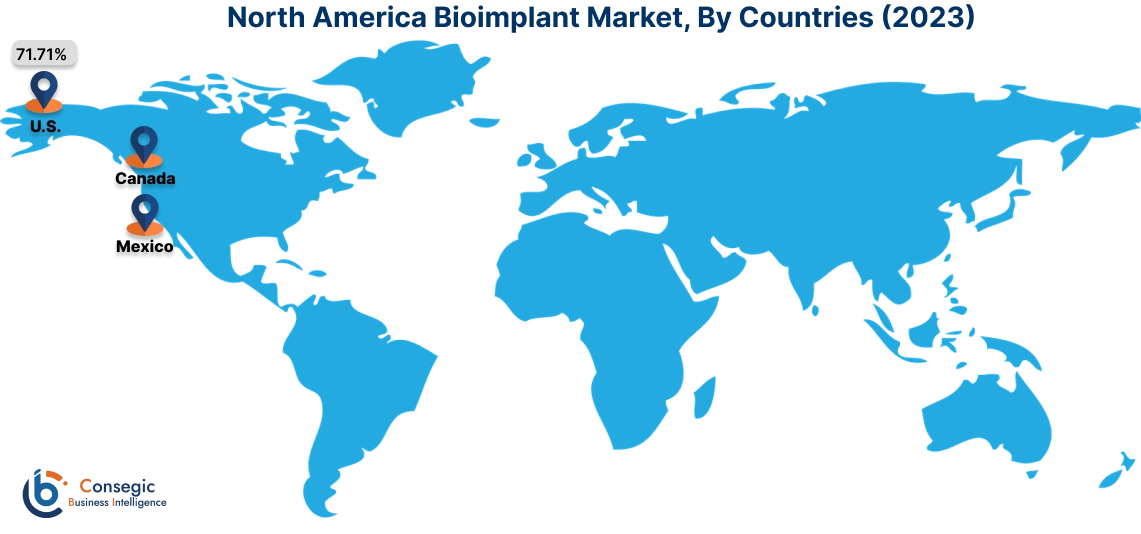
Asia Pacific is expected to witness the fastest CAGR over the forecast period of 8.8% during 2024-2031. The use of dental bioimplants is experiencing a rapid rise in the Asia Pacific region. The rise in the adoption of dental bioimplants is majorly catered by the increased elderly population in the region. These implants improve the consumption of food and speech clarity among the elderly population. Furthermore, they also aid in the preservation of jawbone health by reducing bone loss.
China government has adopted volume-based procurement (VBP) policy. VBP policy aims to achieve a lower price through large-volume procurement, to realize the so called “volume for price” strategy. The introduction of VBP in China has led to a massive increase in manufacturing volume for several type of products including dental bioimplants.
Furthermore, it has been observed, dental treatment has become more affordable for patients in China as regional health authorities in China are facilitating bulk purchases of dental bioimplants which has drastically reduced the cost of treatment. Due to this increased number of individuals in China are opting for dental bioimplant.
- In 2022 according to the State Council of the People’s Republic of China, the demand for dental bioimplants in China has registered double-digit growth in recent years.
Thus, due to government policy and increase in manufacturing, the bioimplant market opportunity is expected to demonstrate a substantial rise in Asia Pacific region.
In Europe there is an increase in the use of titanium alloy and ceramic based bioimplants. In countries such as U.K, Germany, Italy, Netherlands and more, titanium alloy and ceramic based implants are increasingly being adopted in orthopedic surgeries to treat bone related disorders. These titanium alloy and ceramic based bioimplants is increasingly being adopted diue to their increased durability. Additionally, rising aging population and rising demand for joint replacement surgeries the market is demonstrating an exceptional rise in the region. Thus, the increase in need for join replacement among other orthopedic disorders, is expected to create a lucrative opportunity for bioimplant industry.
There is a rise in the need for bioimplants in Latin America. This rise in demand is due to an increase in oral care among individuals in countries such as Brazil, Argentina, Chile amongst others. The installation of dental bioimplants brings significant improvements in patient's quality of life. These implants restore chewing ability and prevent facial sagging due to tooth loss. Furthermore, studies show that there growing adoption of dental bioimplants among older adults in Brazil. Thus, as per the regional trend analysis, due its growing adoption by the adult population, the bioimplant market demand is expected to rise in Latin America.
In Middle East and Africa the bioimplant industry is rising due to the increase in the need for hair bioimplants.. In Dubai, Saudi Arabia, Israel, UAE amongst others there are increase in the number of clinics providing hair bioimplants in order to treat baldness. Dr. Rami Hamed Medical Center (DRHC) is one of the clinics in Dubai that provides Biofibre Hair Implant. Biofiber hair implant, a type of bioimplant is increasingly being adopted as it involves a quick and painless process. Furthermore, these implants don’t turn white or grey due to aging. Thus, even though adoption rate of Biofibre Hair Implant is still low, it is still expected that the bioimplant market demand will rise in Latin America.
Top Key Players & Market Share Insights:
The bioimplant market is highly competitive with major players providing products and services to the national and international markets. Key players are adopting several strategies in research and development (R&D), product innovation, and end-user launches to hold a strong position in the global bioimplant market. Key players in the industry include-
- Arthrex, Inc. (United States)
- LifeNet Health (United States)
- Smith & Nephew (United Kingdom)
- Zimmer Biomet. (United States)
- Edwards Lifesciences Corporation (United States)
- Institut Straumann AG (Switzerland)
- aap Implantate AG (Germany)
- Abbott (United States)
- Dentsply Sirona (United States)
- Medtronic (Ireland)
Recent Industry Developments :
Investment:
- In April 2024, Miach Orthopaedics, Inc., a company transforming the treatment of anterior cruciate ligament (ACL) tears from reconstruction to restoration with the Bridge-Enhanced ACL Restoration (BEAR®) Implant, announced closing of a USD 20 million Series B extension financing round. The funds will support commercial expansion and clinical activities for the BEAR Implant, which has been used to treat nearly 3,000 patients with anterior cruciate ligament (ACL) tears.
Launches:
- In October 2023, Smith+Nephew announced the launch of its REGENETEN Bioinductive Implant in Japan, providing an advanced healing option for patients with rotator cuff tears.
- In July 2023, Smith+Nephew launches REGENETEN Bioinductive Implant in India for rotator cuff repair. The collagen-based REGENETEN Bioinductive Implant supports the body’s natural healing response to facilitate the growth of new tendon-like tissue.
Acquisition:
- In January 2023, Zimmer Biomet Holdings, Inc., a global medical technology leader, announced that it has reached a definitive agreement to acquire Embody, Inc., a privately-held medical device company focused on soft tissue healing, for USD 155 million at closing and up to an additional USD 120 million subject to achieving future regulatory and commercial milestones over a three-year period. The acquisition is expected to be accretive to overall revenue growth and slightly dilutive to adjusted earnings per share in 2023. The acquisition includes Embody's complete portfolio of collagen-based biointegrative solutions to support healing in the most challenging orthopedic soft tissue injuries – including the TAPESTRY® biointegrative implant for tendon healing and TAPESTRY® RC, one of the first arthroscopic implant systems for rotator cuff repair.
Bioimplant Market Report Insights :
| Report Attributes | Report Details |
| Study Timeline | 2018-2031 |
| Market Size in 2031 | USD 246.80 Billion |
| CAGR (2024-2031) | 8.1 % |
| By Product Type |
|
| By Material Type |
|
| By Region |
|
| Key Players |
|
| North America | U.S. Canada Mexico |
| Europe | U.K. Germany France Spain Italy Russia Benelux Rest of Europe |
| APAC | China South Korea Japan India Australia ASEAN Rest of Asia-Pacific |
| Middle East and Africa | GCC Turkey South Africa Rest of MEA |
| LATAM | Brazil Argentina Chile Rest of LATAM |
| Report Coverage |
|
Key Questions Answered in the Report
How big is the Global Bioimplant Market? +
In 2023, the Global Bioimplant Market was USD 134.18 Billion.
Which is the Largest region in the Global Bioimplant Market? +
North America is the Largest region in the Global Bioimplant Market.
Which is the holds the fastest growing market share for Global Bioimplant Market? +
Aisa Pacific is the fastest growing region in the Global Bioimplant Market.
What specific segmentation details are covered in the Global Bioimplant Market? +
Product Type and Material Type are the segments that have been covered in the Global Bioimplant Market.
Who are the major players in the Global Bioimplant Market? +
Arthrex, Inc. (United States), LifeNet Health (United States), Institut Straumann AG (Switzerland), aap Implantate AG (Germany), Abbott. (United States), Dentsply Sirona (United States), Medtronic (Ireland), Smith & Nephew (United Kingdom), Zimmer Biomet. (United States), Edwards Lifesciences Corporation (United States).
